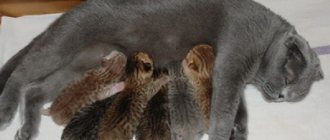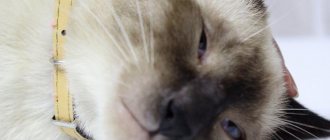What is coronavirus in cats?
Coronavirus in cats is an acute disease caused by a virus that can mutate in the animal’s body. This is the danger - the mutating virus turns from a mildly pathogenic strain into a highly infectious strain that can kill a cat.
Coronavirus is a disease with a mortality rate that can reach 100%
Scientists all over the world are trying to study this virus in order to prevent infection. However, so far few have succeeded. Relatively recently (second half of the 20th century), American biologists made a breakthrough in this area. By 1977, one of the mutated strains was isolated. Already in 1981, this virus was officially registered.
To date, two types of strains of this virus are known:
- FIPV (leads to infectious peritonitis by affecting white blood cells);
- FECV (leads to enteritis and gastroenteritis, affecting the intestinal mucosa).
Based on the severity of the disease, coronavirus is divided into 3 categories:
- asymptomatic (most common - the cat becomes a carrier of the virus, but the disease is chronic);
- mild (manifests as enteritis, but it is curable);
- severe (rare, but it causes serious damage to all internal organs, and infectious peritonitis most often leads to the death of the animal).
Most often, kittens and young cats under 2 years of age become infected with coronavirus. The fact is that this virus enters the living space of many cats, but animals with weak immunity are usually infected. Moreover, the weaker the animal’s immune system, the more dangerous the virus mutates into. With strong immunity, the cat’s body produces antibodies that prevent the insidious virus from multiplying. In such cases, the owner may not even notice that the cat is sick. However, a pet may remain a virus carrier, but no one will even know it.
One of the forms of coronavirus affects blood cells, which subsequently leads to serious disruptions in the functioning of all systems
Is the virus transmitted to humans?
The first thing the owner of a sick cat begins to worry about is whether the virus can be transmitted to humans. Some owners are seriously thinking about euthanasia.
I know a breeder who was advised at the veterinary clinic (where coronavirus infection was diagnosed) to euthanize a sick cat. The breeder was sure that the cat would die, but still began treatment. And veterinarians have not reported whether this disease is contagious to humans or not.
Biologists have already proven that feline coronavirus is not dangerous for humans. That is, the cat’s owner cannot get sick from this viral infection. However, it is already known that humans can be a carrier of the virus. The strain will not attack human blood or epithelial tissue, but the cat breeder can carry the infection mechanically (on clothing, hands, etc.). Moreover, cat coronavirus cannot be transmitted to other animals. This infection is dangerous only for representatives of the cat family.
Typically, a veterinarian suggests euthanizing an animal when the cat definitely cannot be helped, and not because it is dangerous to humans. But unfortunately, the cat owner does not always understand this.
If your cat is diagnosed with coronavirus, you need to make sure that other cats living in the house do not become infected. Especially if the virus has mutated into FIP. A sick pet will need your willpower, care and patience.
Feline coronavirus is not dangerous to humans
What is enteritis, why is it dangerous for cats?
Enteritis is a pathology of the small intestine, accompanied by a violation of its functional abilities. Functions of the small intestine:
Inflammatory processes developing in the gastrointestinal tract of a cat are classified as follows:
- depending on the degree of damage to the mucous membrane;
- according to the origin of the pathology;
- the presence of putrefactive or fermentation processes;
- the peculiarity of the course is the chronic or acute stage.
Enteritis in cats is divided according to the nature of the inflammatory process:
- hemorrhagic - the presence of hemorrhages on the intestinal mucosa;
- catarrhal;
- fibrinous - with the formation of a cheesy coating on the walls;
- ulcerative, complicated by the formation of holes opening into the abdominal cavity;
- necrotic, in which tissue decay and death occurs.
What is coronavirus enteritis in cats? This is an inflammatory lesion of the intestinal epithelium, the upper layer of the mucous surface that lines the organ from the inside. The disease manifests itself as a violation of intestinal functionality. The disease can be viral or bacterial. The bacterial type of disease often develops against the background of an existing illness, for example, tuberculosis, salmonellosis, other infections, poisoning or mechanical trauma.
There are three types of viral enteritis in cats:
- coronavirus - inflammation of the surface layer of the intestinal epithelium occurs, characterized by the absence of elevated temperature;
- parvovirus is a dangerous type of disease that is difficult to treat;
- rotavirus – occurs more often in kittens; therapy started on time ends successfully.
- Coronavirus enteritis in cats is highly treatable. After suffering an illness, the animal forever remains a carrier of the pathogen, which it can transmit to another cat.
- Parvovirus enteritis in cats is considered the most dangerous and difficult to treat. The people have another name for the disease – “plague”. The entire body is subjected to severe intoxication and dehydration.
The entire gastrointestinal system is affected, the level of leukocytes is greatly reduced.
Causes of the disease
The sources of the virus are most often cats and kittens that are sick or have already been sick (they have become virus carriers). The causes of infection are:
- contact with urine or feces of a virus carrier (licking paws after visiting an infectious tray);
- spread of discharge from the nose of a sick or recovered animal (usually within 2–3 months after illness);
- eating contaminated food (if a healthy cat has access to a virus-carrying bowl).
Infection by airborne droplets is less common, as virus particles can spread in the air if an infected cat sneezes, coughs, etc.
Coronavirus, entering the external environment, remains infectious for some time. However, if it gets into a dry environment, its pathogenicity is quickly neutralized. This virus cannot live in low humidity, exposure to ultraviolet rays, or exposure to disinfectants. That is why owners of domestic cats are recommended to clean the cat's litter box daily, treating it with special products. This is not just about those people who keep several cats at home. After all, an animal can re-infect itself. But there is a nuance: if a cat has already been ill, then it does not necessarily have to become a carrier of the virus. Some cats that have overcome this disease do not release viral particles into the external environment.
First, you need to find out whether your cat excretes coronavirus in its feces or not. To do this, you need to test feces for the presence of coronavirus using the PCR method in your cat, and not in any cat from this litter. Not all cats become carriers of coronavirus after contact with it; there are animals that become ill and do not excrete the virus in their feces.
M. G. Isakova, therapist, forum user
https://www.biocontrol.ru/forum/viewtopic.php?f=5&t=5709
Video: animation about the transmission of the virus to a healthy cat
Treatment of COVID-19 in cats and dogs
There are currently no clear instructions on how to treat COVID-19 in animals. Each veterinarian proceeds from his own experience and the condition of the animal. Treatment of coronavirus in dogs and cats is aimed at eliminating symptoms – fever, diarrhea, vomiting.
When your pet is sick, it is important to follow the recommendations for caring for it.
What to do at home
- Be sure to consult your veterinarian by phone. If your symptoms worsen, tell him right away.
- Allocate a separate area for the sick animal so that it does not communicate with other animals or people.
- Wash your hands immediately after contact with the animal, its bowl, tray, or toys.
- Wear a mask when caring for your pet. Important: pets should not wear masks, they can harm them.
- Disinfect bowls, toys and other pet care items.
- Reduce contact with the animal - hugs, kisses, caresses. Do not sit on its bedding.
- Soft items (towels, blankets, bedding) can be washed and reused. Washing powder and hot water work great against the virus.
- Since coronavirus is rarely transmitted through animals, there is no need to treat your pets with disinfectants, wipe them with special wipes, alcohol, or hydrogen peroxide.
How to walk
- If a cat that constantly walks outside is sick, do not let it out of the house.
- Walk your dog at times when there are few people and other animals on the street.
- Don't take your dog to the park. Walk only near the house. Pets spread the coronavirus within their own species.
- If you have a private yard, do not take your dog outside.
- Don't let your pet off the leash.
- Clean up animal feces, as this is how the coronavirus is transmitted to animals.
- Do not visit clinics or groomers with your pet. There is a risk of infecting other animals.
- Do not go to places where there are a lot of dogs - coronavirus infects animals.
- Do not allow strangers to touch your pet.
Symptoms of infection and related illnesses
The viral infection itself may not manifest itself at all (asymptomatic form of the disease). In some cases, your cat may have diarrhea that goes away within a week. Owners often attribute such rare symptoms to poor nutrition, etc. Severe symptoms are not typical for this form of the disease.
Cases of subclinical forms of the disease are slightly less common. In this case, the cat may lose its appetite. A depressed state, refusal to eat, diarrhea or vomiting that went away after a week or two most often indicate this form of coronavirus. If the owner did not ignore this “alarm bell,” then the infection can be diagnosed and treated.
Fortunately, uncomplicated forms of the virus are highly treatable. Although a cat that has recovered from the disease will be a carrier of the virus, it will live a full life, delighting its owners for many years.
The situation is much more serious when a mutated virus leads to a severe form of the disease. Symptoms can be absolutely anything, because pathogenic particles disrupt the functioning of all organs. The most common signs of this form are:
- infectious (viral) peritonitis;
- enteritis and gastroenteritis.
Some people consider such phenomena to be independent diseases, because each of them is accompanied by a number of clinical signs. However, both peritonitis and enteritis are rather concomitant diseases.
Symptoms of the disease depend on its form
Signs of infectious peritonitis
Peritonitis with coronavirus develops rapidly, the clinical picture becomes obvious almost immediately. Symptoms of viral peritonitis are the following:
- apathy, malaise, depression;
- enlarged abdomen (becomes round due to fluid accumulation);
- lack of appetite or complete refusal to eat (often leads to weight loss, exhaustion, anorexia);
- a sick kitten stops growing;
- elevated temperature;
- respiratory failure (shortness of breath, which can develop into pleurisy and cause the death of the animal);
- heart failure (due to fluid accumulation in the abdomen);
- dry plaque may appear on the eyelids;
- mucous membranes may turn yellow (with liver damage);
- malfunctions of the excretory system (kidney failure);
- paralysis of limbs.
A sick cat also changes in appearance. The fur becomes dull and dry (as if dirty and disheveled), the muzzle looks unhappy, etc. The owner of the animal may already react to such changes. This can save the animal's life. After all, it is always better to start treatment as early as possible.
Infectious peritonitis is often confused with ascites (abdominal dropsy). The symptoms are very similar, although with ascites the symptoms are not as serious. Ascites is easier to treat and diagnose. If a veterinarian diagnoses ascites without examination and suggests removing fluid from the abdominal cavity, insist on a quality diagnosis. If FIP is run, valuable time will be lost.
Video: viral peritonitis through the eyes of a veterinarian
Signs of enteritis
Enteritis is characterized by disruption of the small intestine. You can tell that a cat has developed enteritis by the following signs:
- diarrhea (stool may contain mucus, blood, undigested food debris and other impurities);
- vomiting (may be one-time, frequent vomiting is rare with enteritis);
- general depression (lethargy, lack of appetite, poor coat appearance, etc.);
- increased body temperature;
- pain on palpation of the abdomen (the cat will be nervous, meow pitifully, etc.);
- bloating (if this is difficult to determine externally, then you can pay attention to the feces - the feces will be foamy);
- white coating on the tongue, bad breath;
- signs of colds (runny nose, watery eyes, sneezing, rarely coughing).
Some people confuse the signs of enteritis with symptoms of poisoning and other digestive disorders. But there are some nuances here too. The animal's body will try to fight the virus on its own. Fever, tears, runny nose, etc. are the body’s response to aggressive coronavirus particles.
Remember how you feel, for example, when you have a herpes rash on your lips. Weakness, sickness, runny nose, burning eyes, etc. - this is all a reaction of the body. Body temperature rises when antibodies “fight” the virus. The same condition occurs in cats with coronavirus. The combination of digestive and cold symptoms indicates enteritis.
Dogs: canine respiratory coronavirus.
The canine respiratory virus (which causes “kennel cough”) is genetically similar to the human “cold” coronavirus OC43. Most often, infection occurs in autumn and winter. The virus spreads through the air and can cause moderate to severe respiratory distress, pneumonia, loss of appetite and death. During infection, damage to the ciliated respiratory epithelium caused by the virus results in vulnerability to secondary bacterial infections of the lungs. There is currently no known vaccine that protects against canine respiratory coronavirus. Disease management is based on supportive care and prevention of secondary bacterial infections.
Diagnosis of the disease
To protect healthy cats, as well as begin treatment for sick animals, the virus must be detected as early as possible. To do this, you need to examine even those animals that do not have obvious symptoms.
A cat may simply be a carrier of coronavirus, without clinical manifestations. It is difficult to protect an animal living in the same house as a carrier; you can simply also conduct a carrier test.
kamenskaya, forum user, veterinarian
https://www.zoovet.ru/forum/?tem=530310&tid=7
There is no specific test for detecting coronavirus in cats. Diagnostics consists of several components:
- exclusion method - PCR and ICA (checking excrement for helminths and blood for the presence of bacteria and viruses);
- laboratory blood test for the presence of viruses - ELISA and ICA (if there are antibodies to the virus in the blood, then there is a strain);
- antibody titer (this analysis helps to identify a specific amount of antibodies, and this allows treatment to be prescribed in accordance with the severity of the disease), for example, with coronavirus peritonitis, the number of antibodies exceeds 1200;
- microflora test for sensitivity to antibiotics;
- diagnosis by treatment (if the body does not respond positively to symptomatic treatment, then exposure to the virus is needed).
Laboratory tests are needed to diagnose coronavirus
The most accurate diagnostic method is biopsy and histology of the affected tissue. But this is difficult, expensive, requires additional time, and not every clinic practices this method. There are “quick” tests for the presence of the virus, but they are also not available in every clinic. And if there is, then a second check is required (to completely confirm the diagnosis). However, any even confirmed diagnosis will only mean the presence of the virus, but not its nature. Only a veterinarian can determine peritonitis and enteritis based on medical history.
My friends, whose cat fell ill with the so-called “crown”, were tested in several clinics at once. The fact is that in some veterinary hospitals they do not conduct all tests, but only one or two. So they took the PCR test in one clinic, and the titers in another. It turned out to be expensive, but it turned out that the results of all the analyzes turned out to be different. In the most expensive clinic, they compared all these results and summarized the picture - the cat is a carrier of the virus.
Coronaviruses - overview
The family Coronaviridae consists of two subfamilies of viruses - coronaviruses and toroviruses. Although toroviruses can infect both terrestrial and aquatic animals, coronaviruses prefer mammals and birds as hosts. Coronaviruses get their name from their appearance - they have crown-like spikes on their surface and are divided into 4 subgroups - alpha (α), beta (β), gamma (γ) and delta (δ). They can cause various diseases, including pneumonia, reproductive diseases, enteritis, polyserositis, hepatitis, encephalomyelitis, nephritis and others. Pigs, cattle, horses, dogs, cats, camels, rodents, birds, bats, rabbits, ferrets and some species of wild animals can become infected with coronaviruses. However, although coronaviruses can cause serious illness, many infections are subclinical (i.e., asymptomatic).
Treatment of coronavirus
There is no single treatment regimen for coronavirus. Therefore, treatment most often consists of two main components:
- supporting the body in the fight against the virus;
- symptomatic therapy.
Polyferrin-A or Roncoleukin can be prescribed as antiviral drugs effective against coronavirus. But simultaneously with these drugs, antibacterial agents can also be prescribed:
- Tylosin (tylosin tartrate);
- Penicillin;
- Amoxicillin (Amoxycillin);
- Amoxiclav (Amoksiklav);
- Lemomycetin, etc.
Photo gallery: antibacterial drugs
Amoxicillin in the form of a solution or tablets can be purchased at any pet pharmacy.
Levomycetin should not be used simultaneously with penicillin antibiotics
Penicillin is one of the most famous antibiotics in the world.
Any antibiotic can be purchased in several forms (tablets, powder for preparing a solution, etc.)
Analogues of Amoxiclav are preparations with amoxicillin (Panklav, Noroclav, etc.)
If fluid accumulates in the cat's chest or abdomen, it is removed (puncture). There are owners who simply do not give their cat water, but this cannot be done. The animal should drink as much as it wants. And excess fluid is removed with the help of diuretics:
- Hexamethylenetetramine (hexamethylenetetramine);
- Kotervin;
- Lasix;
- Furosemide;
- Indapamide (Indapamidum).
Photo gallery: diuretics for coronavirus
Kotervin is designed for the treatment of urological diseases in cats, but it has a fairly mild effect on sick animals and has a diuretic effect
In fact, Lasix is an analogue of furosemide, but the price of Lasix is slightly higher
Hexamine is sold in 20 ml bottles, so you can buy it individually (one bottle costs about 50 rubles)
Analogues of Indapamide: Ravel, Indap, Arifon, etc.
You can find Furosemide even in a simple human pharmacy; it is available without a prescription
For vomiting and diarrhea, the cat is prescribed sorbents (for example, activated carbon) and antiemetic drugs:
- Metoclopramide;
- Prochlorpromazine, etc.
Since the tablets can be spat out by the cat, the drug is usually administered subcutaneously. In addition, to avoid dehydration, a sick cat must be supported with blood substitutes, saline agents and other solutions that will be prescribed by a veterinarian. Such drugs are administered by drip. The most commonly used:
- glucose solution;
- saline;
- Ringer-Locke solution, etc.
If intravenous drip infusions must be carried out for several days in a row, then a small device is sewn into the cat’s limb during the first dropper (so as not to search for a vein every time and not torment the animal). After the infusion, the injection site is bandaged so that the cat cannot pull it all out. The next day, all that remains is to unbandage the selected area and connect the system. It's convenient and painless.
Maintenance solutions are inexpensive and are sold at any pharmacy
In addition, the pet will need to be supported with vitamins and special complexes. B vitamins (B1, B12, B6 and B5) and ascorbic acid are usually prescribed. Veterinarians also often prescribe immunocorrective drugs:
- Immunoglobulin;
- Feliferon;
- Fosprenil;
- Gamavit;
- Maxidin.
Immunomodulators are also recommended to be administered by injection. Firstly, it will be much more effective, and secondly, the intestinal mucosa will still not accept the medicine well. And when administered, for example, intravenously, the gastrointestinal tract can be avoided.
It is more effective to administer Gamavit intravenously or subcutaneously, at a dose of 0.1 to 0.5 ml per 1 kg of animal body weight
Yulia Gennadievna Toryanik, forum user, veterinarian
https://www.zoovet.ru/forum/?tid=7http:&tem=1064615
Photo gallery: immunomodulators
Whatever immunomodulator you choose, it should be agreed with your veterinarian
When purchasing a medicine, be sure to read the instructions for use
Some immunomodulators have contraindications for use (for example, the age of the animal)
It is better to buy the product at a trusted pharmacy (so as not to run into a fake)
Before going to a veterinary pharmacy, read reviews about the chosen drug
Immediately after the vomiting has passed, feeding the animal must be restored. The cat must have the strength to fight the virus. The food should be high-calorie, but dietary. The animal is not allowed to eat anything fatty. If your cat eats store-bought food, then part of the problem will go away on its own. As a rule, industrial food is already nutritious and dietary (you can choose a more suitable food from the same line). But if the animal eats only natural food, then let it be light but nutritious food:
- chicken bouillon;
- liquid porridge (rice or oatmeal);
- kefir, fermented baked milk, cottage cheese, etc.
The use of antibiotics leads to the destruction of not only pathogenic microbes, but also the “beneficial” intestinal microflora. Therefore, in order for the body to begin to absorb nutrients from food, probiotic preparations are needed. Probiotics populate the intestines with microflora, but the duration of their use is determined by the veterinarian. The following probiotics are commonly prescribed:
- Bifitrilak;
- Fortiflora;
- Enterol;
- Zoonorm;
- Subtilis, etc.
Photo gallery: probiotics for coronavirus
Bifitrilak contains not only prebiotics and probiotics, but also sorbents
Many probiotics can be bought at a regular veterinary pharmacy, while others will have to be ordered
Probiotics manufactured in Russia tend to be cheaper
The probiotic Fortiflora is available, so you can buy this product in a specialized store
Some probiotics (for example, Enterol) are used to treat both humans and animals
A veterinarian I know told me that probiotics are used throughout the entire antibacterial course. In some cases, antibiotics are no longer used, but lactobacilli still have to be given, since the natural microflora suffers more than other organs. If the coronavirus has progressed from a chronic form to infectious peritonitis, then the intestines are a kind of battlefield between the virus and antibiotics. However, he warned me that if you self-medicate and overuse probiotics, your cat’s body may get used to them. And this is an even more serious problem.
After treatment for enteritis or peritonitis, the cat owner should avoid raw fish, vegetables and foods that are prohibited even for healthy cats. The intestinal mucosa remains vulnerable for some time after an illness, so fiber, bones and other rough ingredients can injure it.
Veterinarians believe that the chronic form of coronavirus does not need to be treated, since medications can “plant” the liver, and the virus will not go away from the body. Intervention during a viral illness is only necessary in cases where the virus has mutated to FIP or caused enteritis.
Do kittens get sick and how are they treated?
Kittens are virus carriers even more often than adult cats. In addition to all other ways of infection, babies can also become infected from their mother. In addition, the kitten’s immune system is not yet fully developed. If in a cat’s body the virus simply “sits” for a long time and quietly, then in the kitten’s body it can cause rapid and irreversible processes. Enteritis and peritonitis are the most common diseases that occur in kittens with a crown. Kittens die from coronavirus infection in most cases.
Kittens also get coronavirus
Kittens are treated in the same way as adult cats. There is only one exception - some drugs have age restrictions, so you cannot prescribe and choose a medicine yourself.
There is one rule - do no harm, and I try to follow it. I'm not saying that a cat with bloody diarrhea shouldn't have been treated. I'm talking about a clinically healthy kitten who is cheerful, cheerful and poops exemplary balls.
Tosya, forum user, infectious disease doctor
https://forum.bolen-kot.net.ru/index.php?showtopic=17144
Tests and diagnostics for coronavirus
If you suspect COVID-19 in your dog or cat, consult your doctor. The main criterion for diagnosis is the presence of the patient among the people with whom the animal lives. They are the main cause of infection in a pet.
Unfortunately, not all veterinary clinics test for coronavirus. Often it is necessary to negotiate with the human laboratory, acting through a veterinarian. He will take blood and send it for analysis, if possible. You can also use tests that are sold in human pharmacies, but the error rate is high.
Disease prevention
Pfizer has developed the only intranasal vaccine designed to protect against the coronavirus, Primucell. However, veterinarians cannot guarantee absolute protection to owners of vaccinated cats. There are a number of good reasons for this:
- Primucel was created to prevent coronavirus peritonitis.
Veterinarians do not provide a 100% guarantee of protection after vaccination.
- If the cat is already infected with the virus, then the vaccination will provoke the emergence of an infectious process.
- The effectiveness of Primucel has not yet been scientifically proven.
Most veterinarians recommend preventing coronavirus infection by following simple rules:
- the cat must have comfortable living conditions (cleanliness, dryness, etc.);
- the animal’s diet should be balanced (with plenty of vitamins and microelements);
- it is necessary to observe basic hygiene rules;
- the pet’s habitat must be regularly disinfected;
- Each new kitten must be shown to a veterinarian before moving into the house;
- Contact of a domestic cat with stray animals should not be allowed;
- in order for the cat’s immunity to resist viruses, complications must be prevented (all diseases must be treated immediately and quickly);
- the cat must be periodically treated for fleas and worms;
- the animal should not experience stress (this reduces immunity).
Coronavirus in cats is a viral infection that most often affects kittens and young cats under 2 years of age. The virus enters the animal's body and leads to a chronic form of the disease. When immunity decreases and other negative factors appear, the virus strain mutates. This is how more severe, complicated forms of the disease appear. The most common signs of coronavirus are infectious peritonitis and enteritis. Treatment in both cases is symptomatic and antibacterial. However, therapy does not always lead to the desired result; many cats die from this infection.
COVID-19 and pets
Recently, 2 dogs in Hong Kong, 1 cat in Belgium, 2 cats in New York, 5 tigers and 3 lions at the Bronx Zoo tested positive for the virus that causes COVID-19 (SARS-CoV-2). The first dog was a 17-year-old Pomeranian with multiple underlying health conditions that belonged to a COVID-19 patient. The dog gave "weak positive" results on five molecular tests over a 2-week period. When two other types of COVID-19 tests were used (culture and serology), the dog tested negative. This indicates that the dog did not develop antibodies against SARS-CoV-2, meaning that the virus never caused a strong immune response. The second dog that tested positive for COVID-19 was a 2-year-old German Shepherd that also belonged to a COVID-19 patient.
Not surprisingly, a COVID-19 patient had a Belgian cat that tested positive for the virus. The cat began showing symptoms a week after its owner became infected. Like the Belgian cat, the two cats that tested positive for the virus in New York showed mild signs of respiratory illness. In at least one of these two cases in New York, the cat belonged to a person confirmed to have COVID-19. Tigers and lions at the Bronx Zoo are also believed to have become infected after interacting with a zoo employee who had COVID-19.
The most remarkable information about pets' susceptibility to COVID-19 comes from the first scientific study on the subject. The researchers found that SARS-CoV-2 replicates poorly in dogs, pigs, chickens and ducks, but more efficiently in ferrets and cats. To study the effect of SARS-CoV-2 on cats, scientists inoculated five 8-month-old cats with the virus. They observed SARS-CoV-2 RNA in the turbinates, soft palate, tonsils, trachea and small intestine of vaccinated cats. Lung tissue was negative for the virus. Scientists found infectious viral particles (not just viral RNA) in two cats, indicating active infection.
In the second part of the experiment, the scientists placed three healthy cats in close proximity to three cats infected with the virus. They did this to test whether infected cats could transmit the virus to other cats. Only one out of three unvaccinated cats tested positive for SARS-CoV-2 RNA. This indicates that in some cases, infected cats can transmit the disease to other cats.
The results of this study have been largely replicated by another research group. While this is intriguing, it is important to note a few key points about these studies and their results.
- Viral infection conditions typically relied on very high doses of virus.
- They do not reflect what happens during normal interactions between an infected person and their pet.
- None of the infected cats and dogs showed any symptoms.
- Another, much less publicized observational study found that cats living in close proximity to COVID-19 patients were unlikely to contract the disease themselves.
- There is no evidence that infected cats and dogs can transmit the disease to humans.
We must take all these points into account when interpreting the study results and their implications. “Everyone agrees that our pets pose little threat to us being exposed to the novel coronavirus,” said veterinarian Ernie Ward. The SARS-CoV virus that caused the 2003 epidemic could also infect cats, but there was no evidence that cats were infected by humans.
Treatment
To cleanse the body, saline is administered. solution. Diarrhea, as a rule, is stopped only in exceptional cases, because... This is a natural process that allows you to cleanse the body of the virus.
In general, treatment depends on the stage of the disease. For example, in a mild stage, you can give your pet water to drink, avoiding the introduction of saline. solution. Antibiotics are used depending on the course chosen. There is no clear opinion about their use.
As a rule, Imodium or Cifran are used. Much depends on the condition, age, individual characteristics and the results of the tests performed. The dosage is calculated depending on the weight of the animal.
Painkillers used include Besalol and Belastezin . To stop hemorrhage (for example, with an open ulcer) - Vikasol . Much attention is paid to diet and vitamin complexes. These could be: Beafar, Pancreatin, Festal . Treatment of coronavirus enteritis at home is impossible.











